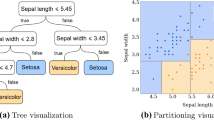Abstract
The information content of rules is categorized into inner mutual information content and outer impartation information content. Actually, the conventional objective interestingness measures based on information theory are all inner mutual information, which represent the confidence of rules and the mutual information between the antecedent and consequent. Moreover, almost all of these measures lose sight of the outer impartation information, which is conveyed to the user and help the user to make decisions. We put forward the viewpoint that the outer impartation information content of rules and rule sets can be represented by the relations from input universe to output universe. By binary relations, the interaction of rules in a rule set can be easily represented by operators: union and intersection. Based on the entropy of relations, the outer impartation information content of rules and rule sets are well measured. Then, the conditional information content of rules and rule sets, the independence of rules and rule sets and the inconsistent knowledge of rule sets are defined and measured. The properties of these new measures are discussed and some interesting results are proven, such as the information content of a rule set may be bigger than the sum of the information content of rules in the rule set, and the conditional information content of rules may be negative. At last, the applications of these new measures are discussed. The new method for the appraisement of rule mining algorithm, and two rule pruning algorithms, λ-choice and RPCIC, are put forward. These new methods and algorithms have predominance in satisfying the need of more efficient decision information.
Similar content being viewed by others
References
Yao Y Y, Zhong N. An analysis of quantitative measures associated with rules. In: Zhong N, Zhou L, eds. Proceedings of Pacific-Aisa Conference on Knowledge Discovery and Data Mining, LNAI, vol. 1574. Berlin: Springer-Verlag, 1999. 479–488
Hilderman R J, Hamilton H J. Knowledge Discovery and Measures of Interest. London: Kluwer Academic Publishers, 2001
Ohsaki M, Sato Y, Yokoi H, et al. Investigation of rule interestingness in medical data mining. In: Tsumoto S, et al., eds. LNAI, vol. 3430. Berlin: Springer-Verlag, 2005. 174–189
Ohsaki M, Sato Y, Yokoi H, et al. Evaluation of rule interestingness measures with a clinical data set on hepatitis. In: Boulicaut J F, et al., eds. LNAI, vol. 3202. Berlin: Springer-Verlag, 2004. 362–373
Hilderman R J, Hamilton H J. Knowledge discovery and interestingness measures: a survey. Technical report, University of Regina, 1999
Balaji P, Alexander T. Unexpectedness as a measure of interestingness in knowledge discovery. Decis Supp Syst, 1999, 27: 303–318
Ailberschatz A, Tuzhilin A. What makes patterns interesting in knowledge discovery systems. IEEE Trans Knowl Data Eng, 1996, 8(6): 970–974
Liu B, Hsu W, Chen S. Using general impressions to analyze discovered classification rules. In: Proc. of 3rd Int. Conf. on Knowledge Discovery and Data Mining. California: AAAI Press, 1997. 31–36
Liu B, Hsu W. Post-analysis of learned rules. In: Proc. of 13rd Int. Conf on Artificial Intelligence. California: AAAI/MIT Press, 1996. 828–834
Hamilton H J, Shan N, Ziarko W. Machine learning of credible classifications. In: Abdul S, ed. Proceedings of Australian Conference on Artificial Intelligence, LNCS, vol. 1342. Berlin: Springer-Verlag, 1997. 330–339
Shapiro G S, Discovery, analysis and presentation of strong Rules. Knowledge Discovery in Databases. California: AAAI/MIT Press, 1991. 229–248
Jaroszewicz S, Simovici D. A general measure of rule interestingness. In: De Raedt L, Siebes A, eds. Proceedings of European Conference on Principles of Data Mining and Knowledge Discovery, LNCS, vol. 2168. Berlin: Springer-Verlag, 2001. 253–265
Gago P, Bento C. A metric for selection of the most promising rules. In: Zytkow J M, Quafafou M, eds. Proceedings of European Conference on the Principle of Data Ming and Knowledge Discovery, LNCS, vol. 1510. Berlin: Springer-Verlag, 1998. 19–27
Zhong N, Yao Y Y, Ohshima M. Peculiarity oriented multi-database mining. In: Zytkow J M, Rauch J, eds. Proceedings of European Conference on Principles of data Mining and Knowledge Discovery, LNCS, vol. 1704. Berlin: Springer-Verlag, 1999. 136–146
Hamilton H J, Fudger D F. Estimationg DBLearn’s potential for knowledge discovery in databases. Comput Intell, 1995, 11(2): 280–296
Symth P, Goodman R M. Rule induction using information theory. In: Piatetsky-Shapiro G, Frauley W J, eds. Knowledge Discovery in Databases. California: AAAI/MIT Press, 1991
Freitas A A. On rule interestingness measures. Knowledge-based Syst, 1999, 12: 309–315
Dong G Z, Li J. Interestingness of discovered association rules in terms of neighborhood-Based unexpectedness. In: Wu X D, Kotagiri B, Korb B, eds. Proceedings of Pacific-Asia Conference on Knowledge Discovery and Data Mining, LNAI, vol.1394. Berlin: Springer-Verlag, 1998. 72–86
Shore J E, Johnson R W. Axiomatic derivation of the principle of maximum entropy and the principle of minimum cross-entropy. IEEE Trans Inf Theory, 1980, 26(1): 26–37
Hu D, Li H X. The entropy of relations and a new approach for decision tree learning. In: Wang L P, Jin Y C, eds. LNAI, vol. 3614. Berlin: Springer-Verlag, 2005. 378–388
Author information
Authors and Affiliations
Corresponding author
Additional information
Supported in part by the National Natural Science Foundation of China (Grant Nos. 60774049 and 40672195), the Natural Science Foundation of Beijing (Grant No. 4062020), the National 973 Fundamental Research Project of China (Grant No. 2002CB312200) and the Youth Foundation of Beijing Normal University
Rights and permissions
About this article
Cite this article
Hu, D., Li, H. & Yu, X. The information content of rules and rule sets and its application. Sci. China Ser. F-Inf. Sci. 51, 1958–1979 (2008). https://doi.org/10.1007/s11432-008-0130-1
Received:
Accepted:
Published:
Issue Date:
DOI: https://doi.org/10.1007/s11432-008-0130-1




